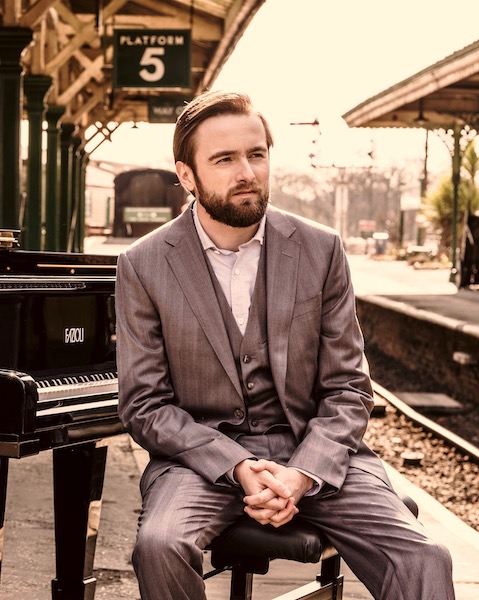Trifonov opens New World Symphony season with world-class artistry

The acclaimed pianist Daniil Trifonov made his belated Miami debut on Saturday night at the New World Symphony’s opening concert of the 2019-20 season. With artistic director Michael Tilson Thomas back on the podium at New World Center after heart surgery this past summer, the concert displayed the fellows of the orchestral academy in peak form in a program that mainly avoided orchestral staples.
Top prize winner of the 2011 Tchaikovsky Competition in Moscow, Trifonov was definitely worth waiting for. He is an artist with the most sensitive musical instincts and an absolutely solid technique that rarely calls attention to itself. Instead of the usual Russian warhorse concertos of Rachmaninoff or Tchaikovsky, Trifonov instead chose the rarely played Piano Concerto in F-sharp minor by Alexander Scriabin.
Scriabin was best known for his experiments with musical mysticism and radical journeys to the edge of tonality in his late sonatas and symphonic works. He began his creative career, however in the Russian romantic tradition. Chopin’s keyboard works held sway over Scriabin’s early compositional efforts and his imprint is clearly delineated in the concerto, completed in 1896.
Unlike Scriabin’s strongly conceived Second Symphony, written five years later, the Piano Concerto is diffuse and less than coherent in formal structure. While not quite a neglected masterpiece, it is a work worth hearing for its melodic invention and deserves more frequent performance. Surprisingly for the work of a composer-pianist, the score mostly avoids flashy pyrotechnics. An aura of reserved introspection dominates two of the three movements in the 28-minute work.
Trifonov’s pearly tone and sensitivity of touch captured the angst-tinged melancholy of the first movement. In a brief interlude of greater abandon, he handled the complex chords with darting lightness. Tilson Thomas balanced the exposed wind and horn parts superbly against the restrained piano writing and the strings glistened with tonal luster. The full, warm sonority of Corbin Castro’s horn solos almost suggested a second solo instrument.
The middle Andante is a theme and variations on a reflective hymn melody, played with intense feeling and spaciousness by the strings. Trifonov’s feathery figurations formed a duo with Jesse McCandless’s mellow clarinet in one vignette. He played the more exuberant variations with daunting speed and accuracy.
The concluding Allegro moderato is longer than the first two movements combined and becomes undeniably repetitive. Still the arpeggiated Chopinesque rhythms and a secondary theme that could have come from a Rachmaninoff concerto are appealing. Finally cutting loose in flashes of big boned pianistic bravura, Trifonov exhibited digital dexterity of the most extraordinary variety. He even managed to infuse the too- frequently-repeated material with fire and excitement. At times the piano almost sounded like a full orchestra, so large was his sonority. In a bold stroke, Scriabin has the pianist hold the final note with the pedals after the orchestra has played what sounds like a concluding fortissimo chord. Trifonov brought off that quiet surprise ending with typical understated musicality. Solo work from flutist Jack Reddick and oboist Emily Beare were standouts among the excellent orchestral component.
An immediate standing ovation brought Trifonov back for more Scriabin. His encore of the Etude, Op. 42, No. 4 was exquisitely etched, a moody vignette rather than a cascade of notes. It was the perfect exit for this brilliant pianist who needs to be heard here again in more of his wide repertoire.
When he is top form, Tilson Thomas’ interpretations of large-scale symphonic works can be revelatory. That is particularly true of his performances of Mahler symphonies.
Excerpts from Berlioz’s dramatic symphony Romeo and Juliet were on an equally high level Saturday night. With its conflation of tone poems, cantata and French opera, the complete score can be unwieldy. The orchestral sections, however, are prime Berlioz.
Looking well and conducting with vigor, MTT had the New World fellows sounding like a world-class ensemble. (His podium manner was somewhat more restrained than previously.)
From the transparent textures of the fugal strings and winds in the introduction (depicting the enmity between the Montagues and the Capulets), the performance was distinguished by supple instrumental detailing. The opening of the ”Love Scene” was played as if in a hushed whisper with a surge of tension rumbling beneath the soft tones. When the big theme sang forth from the cellos, Tilson Thomas’ natural tempo allowed space for the fervor to build organically. The fullness and bloom of the viola section fully captured the romantic pulse and momentum.
The “Queen Mab Scherzo” finds Berlioz at his most wildly imaginative. Lithe string articulation kept the principal motifs bright and the two harps came through with clarity, even above the full ensemble. Under Tilson Thomas’ taut pacing, four horns were sonorous and the percussion contingent incisive. The ensemble’s playing of this difficult movement was so vigorous and precise that MTT encouraged the audience to applaud.
He evoked Romeo’s sadness and isolation in the “Romeo Alone” segment with gradations of softness. The crescendo that builds to the “Festivities at Capulets” engendered a shot of adrenalin with the ballroom music taken at a crisp clip. Brass climaxes were firm and solid but never bombastic. MTT’s Berlioz emerged as subtle, elegant and strikingly original.
Following the season-opening National Anthem, the academy’s new conducting fellow Chad Goodman led Beethoven’s Egmont Overture. Following an unusually slow introduction, there was a real sense of urgency in the allegro. The rich compass and nicely varied dynamics of Angelo Quail’s solo clarinet stood out amid fine ensemble playing. Impressive solidity from the four horns and two blazing trumpets put an extra exclamation on the coda.
The New World Symphony repeats the program 2 p.m. Sunday at the New World Center in Miami Beach.
The New World Symphony presents “Viola, Viola” October 16-19 with guest artists Cynthia Phelps, Joinathan Vinocour, Tabea Zimmerman, Kim Kashkashian, Matthew Lipman, Nadia Sirota and Roberto Díaz. nws.edu; 305-673-3331.
Posted in Performances
Leave a Comment
Sun Oct 13, 2019
at 12:06 pm
No Comments






